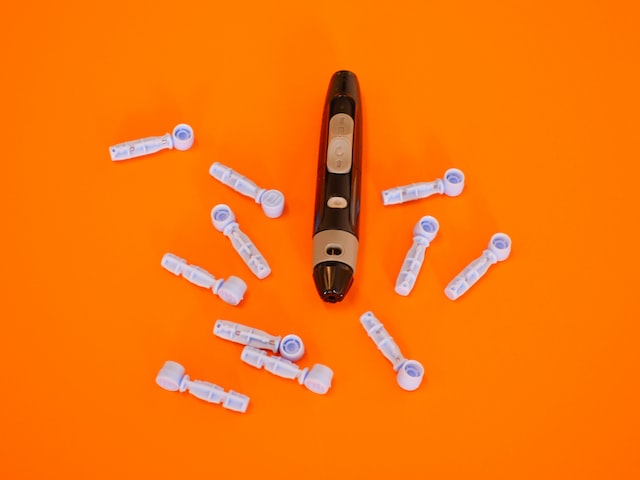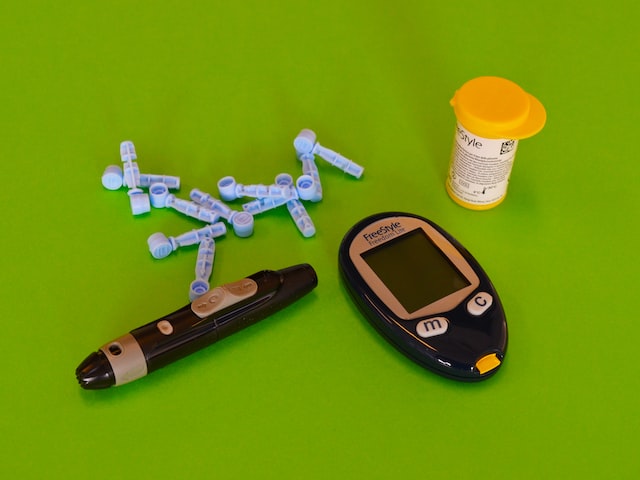Lancets are small, disposable needles that are used to prick the skin to obtain a small blood sample for testing, while blood strips are small strips of paper or plastic that are used to test the glucose levels in a drop of blood. Lancets are used to obtain the blood sample, while blood strips are used to test the glucose levels in the obtained blood sample.
What are lancets?
Lancets are small needles that are used to puncture the skin in order to obtain a small blood sample. Lancets are typically used with a glucometer, which is a device that measures the level of glucose in the blood.
What are test strips?
(Photo by Diabetesmagazijn.nl on Unsplash )

Test strips are thin pieces of plastic that are used with blood glucose meters to test blood sugar levels. A small drop of blood is placed on the strip, which is then inserted into the meter. The meter reads the strip and displays the result. Test strips are typically disposable and must be replaced after each use.
What is the difference between the two?
Lancets and blood strips are both used in the process of monitoring blood glucose levels, but they serve different purposes. Lancets are small, disposable needles that are used to prick the skin to obtain a small blood sample. They are typically used with a lancing device, which holds the lancet in place and allows the user to control the depth of the prick. Lancets come in different gauges (thickness of the needle) to accommodate different skin types and sensitivities.
Blood strips, on the other hand, are small strips of paper or plastic that are used to test the glucose levels in a drop of blood. They are used in conjunction with a glucose meter, which reads the strip and displays the glucose level on a screen. Blood strips are typically specific to a particular type of glucose meter and should not be used with other types of meters. In summary, lancets are used to obtain a small blood sample, while blood strips are used to test the glucose levels in the obtained blood sample.
How to choose the right one for you
Choosing the correct lancet depends on several factors, including your skin type, the level of sensitivity you require, and your personal preferences. Here are some things to consider when choosing a lancet:
- Gauge: Lancets come in different gauges, which refer to the thickness of the needle. A higher gauge number means a thinner needle, and a lower gauge number means a thicker needle. Thinner needles (higher gauge numbers) are less painful, but they may not be suitable for people with thicker or calloused skin. Thicker needles (lower gauge numbers) may be more painful, but they may be more effective for people with thicker or calloused skin.
- Depth Setting: Some lancing devices have adjustable depth settings, which allow you to control the depth of the prick. This feature can be useful for people with sensitive skin, as it allows you to set the depth to a level that is comfortable for you.
- Sterilization : check if the lancet is sterilized or not
- Brand: Some people may prefer a certain brand of lancets based on their personal experiences or recommendations from healthcare professionals.
- Ease of use: Some lancets are easier to use than others, so it’s important to consider the design of the lancet and the lancing device to ensure that they are easy to use and comfortable for you.
Ultimately, the best lancet is the one that works best for you. It’s a good idea to try different types and gauges of lancets to find the one that is most comfortable and effective for you.
Can you use testing strips more than one?
No, diabetes test strips are designed for single use only. They are typically used in conjunction with a glucose meter to test the glucose levels in a drop of blood. Once a strip is used, it should be discarded, as it may not provide accurate results if used again. Also, using a strip more than once can lead to contamination of the strip, which can affect the accuracy of the result.
Additionally, Most of the test strips come in a vial or a container, once opened it’s recommended to use the strips within a certain period of time, usually within 6 months, as the strip can lose its accuracy over time.
It’s important to always follow the manufacturer’s instructions for using diabetes test strips, as well as to keep in mind that these strips are an important part of diabetes management and their proper use can help ensure accurate and reliable results.
Can you use lancets more than one?
It is not recommended to reuse lancets. Lancets are designed for single use only, and they should be discarded after each use. Reusing a lancet increases the risk of infection and can also lead to inaccurate results. This is because the needle can become dull or bent after the first use, which can make it difficult to obtain a clean, precise sample of blood.
Reusing lancets can also increase the risk of cross-contamination, as the needle may have come into contact with harmful bacteria or viruses from the previous use.
It is important to follow the manufacturer’s instructions for using lancets, and to always use a new, sterile lancet for each blood glucose test. This will help to ensure accurate and reliable results, and to minimize the risk of infection.
Also, it’s important to handle the lancets with care and to not touch the needle tip, as it can lead to injury or contamination.
Are there reusable lancets?
(Photo by Diabetesmagazijn.nl on Unsplash )

There are some lancing devices that are designed to be reusable, meaning that the same device can be used multiple times with disposable lancets. These devices typically have a mechanism that allows the user to easily insert and remove the lancet, and they are designed to hold the lancet securely in place during use.
However, it’s important to note that even though the lancing device is reusable, the lancets themselves are still disposable and should be discarded after each use. This is because lancets are designed for single use only and reusing them increases the risk of infection and inaccurate results.
Reusable lancets are not commonly found in the market, most of lancets are disposable, and it’s important to follow the manufacturer’s instructions for using lancets, and to always use a new, sterile lancet for each blood glucose test. This will help to ensure accurate and reliable results, and to minimize the risk of infection.
It’s always recommended to consult with your healthcare provider before making any changes to your diabetes management routine.
What finger do you use for lancet?
The finger that is typically used for lancing with a lancet is the fingerpad of the finger. The fingerpad is the fleshy part of the finger where there is a small amount of fat and less nerve endings, making it less painful to prick. The most common fingers used for lancing are the fingers of the non-dominant hand, such as the middle, ring, and little fingers.
It’s also important to rotate the finger used for lancing, and it’s not recommended to use the same finger repeatedly. This is because lancing the same finger repeatedly can cause calluses or hardening of the skin. Rotating the fingers that you use for lancing will help reduce pain and discomfort, as well as help to prevent calluses and hardening of the skin.
It’s always recommended to consult with your healthcare provider before making any changes to your diabetes management routine, and to follow the manufacturer’s instructions for using lancets and lancing devices.
Can I use a lancet without a device?
Lancets are small, sharp needles that are used to prick the skin and draw a small amount of blood. They are typically used with devices known as lancing devices or lancet holders, which help to control the depth of the cut and provide a safe, sterile environment for blood collection. While it is possible to use a lancet without a device, it is not recommended, as this can increase the risk of infection and lead to inaccurate results.
Why do we wipe the first drop of blood?
When you prick your finger with a lancet, the first drop of blood that appears is called the “heel.” This blood is not as accurate of a sample as subsequent drops, because it can be contaminated with tissue fluid. That’s why it’s important to wipe away the heel before taking your blood sample.
Why does lancet hurt?
Lancets are small, sharp needles that are used to prick the skin and draw blood. They are used with lancing devices, which are devices that allow for a controlled and shallow puncture of the skin. While lancets can be used without a lancing device, using one can help to make the process less painful.
Lancets can be made of different materials, including stainless steel, plastic, or titanium. Some are even coated with silicone to help make them more comfortable to use. The material of the lancet will affect how sharp it is and how much it hurts when used.
The pain from a lancet is usually only momentary and is caused by the needle puncturing the skin. Some people may feel a brief stinging sensation while others may feel nothing at all. It is generally not a painful procedure, but everyone experiences pain differently.
What is the difference between 30g and 33g lancets
There are a few key differences between 30g and 33g lancets that are important to be aware of. The main difference is that 33g lancets are slightly thinner, meaning they will cause less pain when used. They also tend to be more precise, so there is less chance of them causing an inaccurate reading. Finally, 33g lancets are generally more expensive than 30g lancets.
What is the standard lancet size?
Lancets are small needles that are used to puncture the skin and obtain a small blood sample. They come in different sizes, but the most common lancet size is 23 gauge. Test strips are strips of paper or plastic that are used to absorb a small blood sample.
Are test strips more accurate?
The accuracy of diabetes test strips can vary depending on a number of factors, such as the type of strip, the brand, and how well the strips are stored and handled. In general, however, most diabetes test strips are considered to be very accurate.
Most glucose test strips have a precision of plus or minus 15% to 20% of the actual blood glucose level. Blood glucose meters are also required to meet certain accuracy standards set by international organizations such as ISO and FDA. These standards are in place to ensure that the test results are accurate and reliable.
However, the accuracy of the test results can be affected by various factors such as using expired strips, not following the manufacturer’s instructions, not cleaning the meter properly, and using the strips with the wrong meter.
It’s important to always follow the manufacturer’s instructions for using diabetes test strips, and to store and handle the strips properly to ensure accurate and reliable results. If you ever have any concerns about the accuracy of your test results, it’s important to consult with your healthcare provider.
Why do I get two different blood sugar readings on different fingers?
There are several reasons why you may get two different blood sugar readings on different fingers:
- Blood flow: Blood flow to different fingers can vary, which can affect the amount of glucose in the blood sample. This can lead to slightly different results when testing on different fingers.
- Temperature: Cold fingers can cause the blood vessels to constrict, which can make it difficult to obtain a blood sample. This can lead to slightly different results when testing on different fingers.
- Calluses: Testing the same finger repeatedly can cause calluses or hardening of the skin, which can make it difficult to obtain a clean, precise sample of blood. This can lead to slightly different results when testing on different fingers.
- Handling the lancet: If the lancet is not handled properly and the needle is not inserted perpendicular to the skin, it can cause the needle to bend or become dull, which can lead to inaccurate results.
- Human Error: Sometimes, it can be due to human error, such as not cleaning the finger properly before the test, or not using a new, sterile lancet for each test.
It’s always recommended to consult with your healthcare provider before making any changes to your diabetes management routine, and to follow the manufacturer’s instructions for using lancets, lancing devices, and test strips. Rotating the fingers that you use for testing will help to minimize these variations, and your healthcare provider can help you understand what variations are normal for you and when you should be concerned.
How do test strips work?
The test strips contain a small amount of the enzyme glucose oxidase, which reacts with the glucose in the blood sample to produce hydrogen peroxide. The amount of hydrogen peroxide produced is proportional to the glucose level in the blood sample. Some glucose meters use a electrochemical process called amperometry, where the current flow through the enzyme/glucose is measured.
The test strips are designed to be easy to use and provide accurate results. However, it’s important to always follow the manufacturer’s instructions for using diabetes test strips, and to store and handle the strips properly to ensure accurate and reliable results.
What does sugar test measure?
A sugar test, also known as a blood glucose test, measures the level of glucose, a type of sugar, in the blood. Glucose is a primary source of energy for the body’s cells and is essential for proper bodily function.
A sugar test is typically used to diagnose and monitor diabetes, a condition in which the body is unable to properly regulate the level of glucose in the blood. In people with diabetes, the level of glucose in the blood can be either too high (hyperglycemia) or too low (hypoglycemia). High blood sugar levels can lead to serious health complications, such as heart disease, kidney damage, and nerve damage, if left untreated.
It’s important to note that a sugar test measures the glucose level in the blood at a specific moment, and the glucose level can fluctuate throughout the day due to various factors such as food intake, physical activity, stress and medications. Therefore, it’s important to consult with your healthcare provider and follow their advice on how often you should test your glucose level.
Featured Image By – Photo by Diabetesmagazijn.nl on Unsplash








